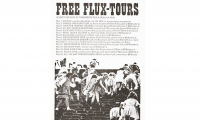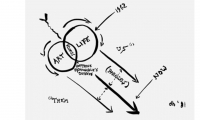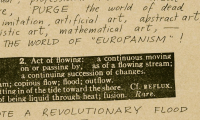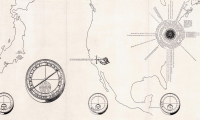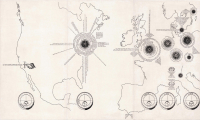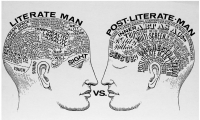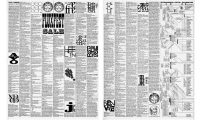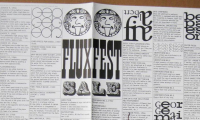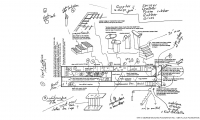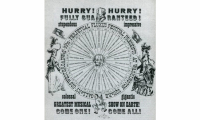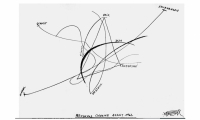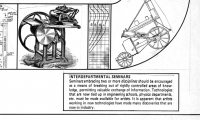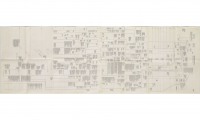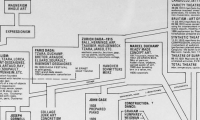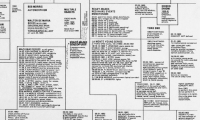PIECES
György Ligeti : Poème Symphonique pour cent métronomes (1962) [10’]
Davide Tidoni : There is no listening without intervention (obstacle, feedback & my target is your eyes) (2016-2019)
for a large group of performers [20’]
David Helbich : Line-up (2010)
for 5 performers and voice-off [15’]
Louis D’Heudières : Laughter Studies 3 (2016)
for three performers [10’]
Annika Kahrs / Louis D’Heudières : the lord loves changes, it’s one of his greatest delusions (2018)
for keyboard and whistling choir [16’]
Alison Knowles: Wounded Furniture (1965)

PERFORMERS
P.A.R.T.S
Liesa Van der Aa
Jean-Luc Fafchamps
Michael Schmid
Davide Tidoni
Hanna Kölbel
George Maciunas, Fluxus Manifesto, 1963
George Maciunas: "Diagram of Historical Development of Fluxus and Other Dimensional, Aural, Optic, Olfactory, Epithelial and Tactile Art Forms", aka "the Cage Chart"

The importance of the Fluxus movement on performance arts can not be overestimated. One point that should be emphasised is the unusual importance of music in an avant-garde involving so many artists coming from visual arts (at least in the 20th century!). Many of the Fluxus keywords like experimentalism, intermedia, unity of art and life, chance, ephemerality, playfulness, were directly imported from the John Cage’s teachings in the sixties. By renaming his exhaustive Diagram of Historical Development of Fluxus and Other Dimensional, Aural, Optic, Olfactory, Epithelial and Tactile Art Forms as the Cage Chart shortly before his death, George Maciunas underscored the composer’s special status without ambiguity(1).

Fluxus stood for a liberation from the euro-centric domination: "Purge the world of ‘Europanism’!", [sic] George Maciunas wrote also in the 1963 Fluxus manifesto(2). They created radical openings to the interdisciplinary, the self-performative, the appearance of event scores, happenings — with a unique attitude towards triviality, a focus on the unremarkable, as Kristine Stiles noted. "Anomaly pertains to how Fluxus artists insisted upon maintaining a relation to the normative while pushing toward the atypical", wrote the same(3).

(1) See the three last pictures of our selection.
Pointed by Astrit Schmidt-Burkhardt in >Maciunas Learning Machines
(2) "Europanism: may be a neologism, rather than a repeated spelling error, implying pan-Europeanism"
(Clive Phillpot, >Fluxus exhibition catalogue, MoMA, 1988)
(3) Kristine Stiles, Anomaly, Sky, Sex, and Psi in Fluxus in >Critical Mass

Composed with and by musicians, framed by two historical Fluxus works by Alison Knowles and György Ligeti (one of his rare but brilliant flirts with Fluxus) the evening is dedicated to much more recent work by artists that act between worlds. The Diagram could be continued. The exploration of the materiality of microphones and their corporeal aspects by Davide Tidoni contrasts with the strict protocol, the abstract choreography and the ephemeral relationship that is created with the public in work by David Helbich. The Laughter Studies series by Louis D’Heudières gets its name from the idea of a world where humans have lost the ability to do things which once came naturally to them, such as laughing. "In such a world, people would have to learn how to laugh, cry, acquire language, even breathe, solely through artificially imitating pre-recorded sounds of these basic functions". As a Grande finale the work by Annika Kahrs for for organ and whistling choir deals with slowly performing a deconstruction of rhythm and melody. Whistling performers confront the prolonged tone of an organ, moving between protest gestures and delicate formations of sound. In this performance, whistling intertwines with music to form a confrontation with its context of protest, creating a musical interaction of tensions.
On the invitation of Guy Gypens, we will bring together works, performers and a public on one of the floors of the Citroën Garage’s Showroom (Kanal) within the context of an 6 months lasting exhibition of the Swiss visual artist-curator John Armleder (April 2020-November 2020), whose work was strongly influenced by the work and personality of John Cage.

Disposition
The first 1 and 2nd floor of the showroom will be equipped with basic light, our own sound system with speakers on stands, an analogue mixing board, long xlr cables and a set of microphones. The space will be used in various directions (cfr the Liquid Room, but without the risers and the multiple sound-systems). Works will be performed by a small crew of ictus musicians, performers of p.a.r.t.s research cycle and possible a larger group of p.a.r.t.s training students. Works with and without clear ending and beginning, mostly without scores, mostly inside the space but not only.

NOTES about the works
DAVIDE TIDONI
There is no listening without intervention (2016-2019) :
This series of pieces is developed by Tidoni as part of his practice based research on sound and listening. Exploring issues concerning: touch, filter, and distance, each of the pieces evokes a situation where the body is used wholly as a medium for experiencing sound in relation to one's present self.
ANNIKA KAHRS / LOUS D’HEUDIERES
the lord loves changes, it’s one of his greatest delusions (2018) :
For organ and whistling choir : slowly performing a deconstruction of rhythm and melody. Whistling performers confront the prolonged tone of an organ, moving between protest gestures and delicate formations of sound. In this performance, whistling intertwines with music to form a confrontation with its context of protest, creating a musical interaction of tensions. LINK
LOUIS D’HEUDIERES
Laughter Studies : The series Laughter Studies gets its name from the idea of a world where humans have lost the ability to do things which once came naturally to them, such as laughing. In such a world, people would have to learn how to laugh, cry, acquire language, even breathe, solely through artificially imitating pre-recorded sounds of these basic functions. Taking this idea as a springboard, all pieces in the series are based around performers vocally imitating and describing assembled collages of sounds.
DAVID HELBICH
Line up (2010): written for the Berliner Maulwerker, a vocal performance ensemble founded by Dieter Schnebel.
From the score : "ok, you all know the drill. when your number is called, step forward and repeat the phrase you've been given. understand? number one, step forward." The Usual Suspect. An ephemeral character study, between strict protocol and the exploration of an active relation with the public (public as a score).
ALISON KNOWLES
Wounded Furniture (1965) : This piece uses an old piece of furniture in bad shape. Destroy it further, if you like. Bandage it up with gauze and adhesive. Spray red paint on the wounded joints. Effective lighting helps. This activity may be performed with one or more performers, and simultaneously with other events.
Agenda for this project
- Date Show Location
-
Thu 15.04 No Fluxus Room CANCELED
 Kanal - Brussels - Belgium
Kanal - Brussels - Belgium

